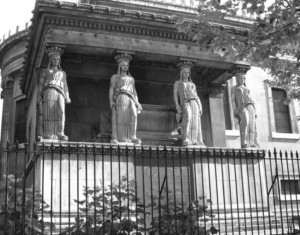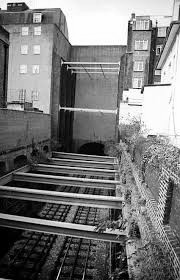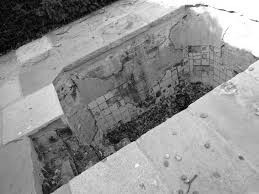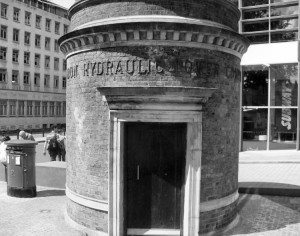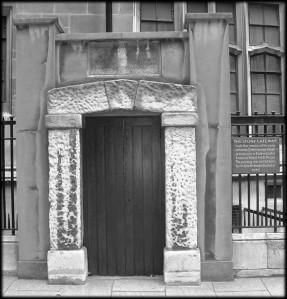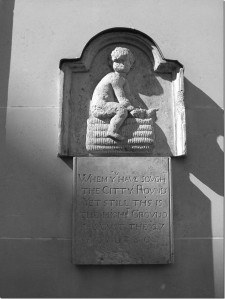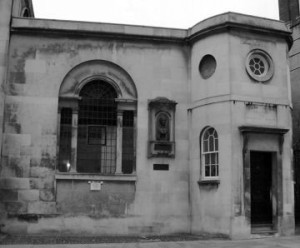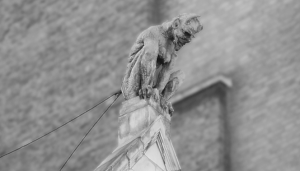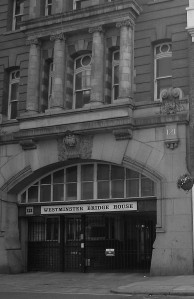St Pancras Church
St Pancras Church on the Euston Road was made in Classic Greek Temple style with a row of beautiful hand maidens supporting the projecting alcoves. The statues were made of Coade’s artificial stone which took three years to make. They were brought to the church looking dainty until they were ready to be put into place. Mr. Charles Rossi, their builder, found that the measurements were a little out and try as he may, could not get them to fit. With a large crowd bemused at his misfortune, Rossi needed to act rather quickly to regain his self respect. He preformed a miracle operation with 12 inches being extracted from their midriff. As the traffic on the boarders of the congestion zone slowly pass by, I wonder how many notice the out of proportion ladies that just don’t look quite right.
The Phoney houses
With the beginning of the first tube line running from Paddington to Farringdon, demand grew for more tube lines within the area. Property was purchased and then demolished to make way for these new lines. To help keep house prices high in the rather posh area of Leinster Terrace Bayswater, a reconstruction looking like terraced houses from the front and more like a film set at the rear was built. How many passers by ever notice this false property?
This rear view photo shows the hidden side of the previous shot. Although unlike the front there is no desire to hide the ugly gap between the houses. Just like a film set complete with iron scaffolding.
Queen Caroline’s Sunken Bath
Queen Caroline was the Princess Di of her day – married to her unfaithful husband King George IV When he decided to leave her the decision made him very unpopular throughout the kingdom. Caroline was already a Brunswick Princess before marrying George; it is said the marriage was arranged to pay large gambling debts. Caroline first arrived in England in 1795 and George was shocked to see that she was no oil painting. She gave birth to a daughter in 1796 by which time George was back to his old ways of having mistresses. Caroline moved from the Royal palace to Montague House on Blackheath in 1797, doing the same as her husband by having orgies and suchlike. In the August of 1804 she decided to leave England for good and live in exile abroad – which is what George had been waiting for. So as to have no reminder of his wife’s pleasurable parties he ordered the demolition of Montague House saying he wanted it razed to the ground. Obeying his wish the house was demolished, though the bits beneath the ground were overlooked. It was not until 1909 that the sunken bath was discovered. It can still be seen inside Greenwich Park along the Eastern Wall near the Charlton way entrance.
Tower Subway
Unnoticed by many of the visitors to the Tower of London is what looks like an oversized brick post box. It is in fact the entrance to the second tunnel that was to be built under the Thames. The first tunnel now runs the tube line from Wapping to Rotherhithe and took fifteen years to dig and at an enormous sum in those days of £600,000. A South African by the name of James Greathead said he could dig a tunnel under the river in under a year at the cost of £16,000 using his own invention of the Greathead Shield tunnelling digger. Digging commenced at four and a half feet a day and took ten months to complete – a staggering success for those times, even allowing for some delay when the digger unearthed 300 silver coins from Henry III times. The tunnel was used for foot passengers and when Tower Bridge was erected around fifty years later the tunnel became redundant. Today it is only used for carrying cables and pipes under the river.
Tothill House of Correction
Just across the road from Westminster Abbey, unnoticed to all the thousands of tourists that visit every day, is a quite street named Little George Street. This gateway was the prison gate for Tothill Fields House of Correction, and was recited here in 1959. On the site of the present Westminster Cathedral stood a correctional facility named Tothill Fields Prison. This was said to be a more desirable place to be incarcerated than most others due to the more humane (in comparison) treatment handed out to its inmates. Maybe this is the reason it only lasted for a period of fifty years. Or was it because the land was wanted for the building of the Cathedral? The main punishment seemed to be the rule of silence; prisoners were not allowed to converse with each other. The other main form of punishment was to withhold their food and the main reason for this to be imposed upon you was being caught talking to another prisoner. According to records of the time, a whipping had only been authorised twice between 1851 and 1855. Henry Mayhew visited the prison in 1861 and in his book ‘Criminal Prisons of London’, praises the staff for ensuring discipline without the need for physical punishment. Most of the inmates were in their early teens but children from the age of five years and upwards were sentenced to be detained there.
The Panyer Boy
When the Panyer boy first sat on his basket, the Great Fire of London was only 22 years old. He has now been sitting on his basket for more than 320 years. Panyer Alley in the Middle Ages was London’s bread market and on a wall of a house in the alley was this stone with a boy seated on a panyer, or bread basket. The little ditty inscribed on the stone is the motto for this website: “When ye have sought the city round yet this is the highest ground. August the 27 1688.” During several rebuilding’s over the years the boy has been moved a few times. During the Second World War he was placed in the safe custody of the Vintners Company. Now day’s he is hidden above the steps of St Paul’s Underground Station, unnoticed by most travellers, he is one of the best hidden gems of London.
The Watch House
Overlooking the graveyard of St. Sepulchre’s in Guiltspur Street, Holborn, is this old watch house. This was built with the increase of body snatching that was an epidemic in the 17th century. The price for bodies that were bought by students of medical science for dissection was high. The only legal bodies that could be obtained were that of murderers, so with more students than bodies, supply and demand put the price at about £50 – a fortune in those times. Inside the watch house, a watchman could keep an eye on the graveyard to stop newly interred bodies being dug up and sold.
The Cornhill Devils
High above the rooftop by St Peter’s Church, Cornhill, are the three angry devils who pour scorn on anyone entering the said church. The story behind them is thus, during the building of the office block next door to the church, the builders stole a foot of the church ground. This act was noted by the rector, the building plans were put back and the architect was made to re-plan his works. So bitter was the architect that he engrossed the rectors face upon one of the devils and set three devils upon the roof to add curses to anyone whom entered the church.
Necropolis Private Station.
Towards the end of the eighteen hundreds cemetery spaces in the metropolis became scarce, so a private company set up a station at 121 Westminster Bridge Road (opposite Waterloo Station) to transport the London dead to Brookwood, Surrey. The waiting rooms had been allotted for the exclusive use of any mourners attending a private funeral. Added to this was also a beautifully equipped mortuary chapel. A single platform awaited the train of the dead. At its peak fifty bodies a day would be transported along this line and would normally total three or four thousand a year. Today, hidden behind an iron gate, is this historic station of the dead.
